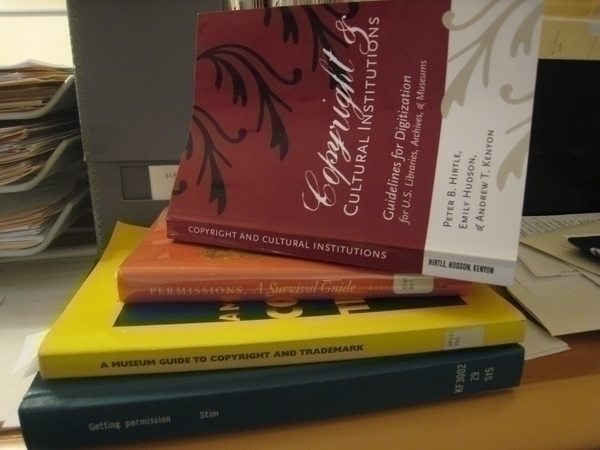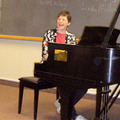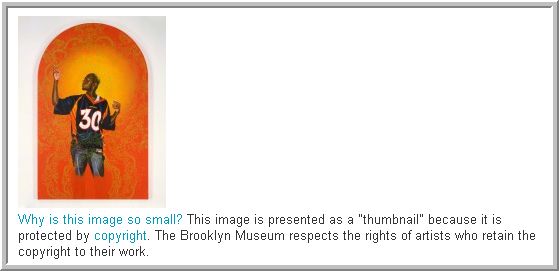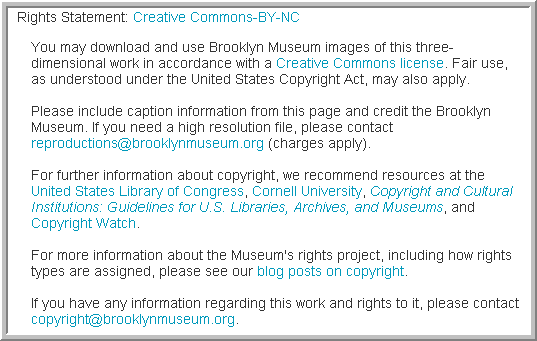Copyright is complicated
Copyright is complicated. What’s protected? What’s not? And it’s even more complicated for art, where the work may not be dated and there are questions about whether it was “published” and what “publication” means. And it’s a legal matter, which is enough to make anyone a bit fearful about making a mistake.
On the other side of the coin, there’s a huge community hungry for images that they can use for a million different projects – websites, blogs, school papers, art projects, mashups. They’re willing to pay attention to whether an image is in the public domain or not, but they don’t always understand what that means, and the institutions with the images rarely provide useful guidance (see paragraph 1).

My book shelf: I’ve been doing a LOT of reading, both books and on line.
Over the past several months, Brooklyn Museum staff members have been wrestling with this problem. We respect artists’ rights and are working on contacting artists and their estates for our entire Contemporary Art collection. (Arlene Yu will talk about that more in a later blog post.) We also want to be as open and transparent as possible with our community about the images we provide on our website.
Our first decision was to provide at least thumbnail images of all art works on our website, as allowed under the fair use exemption in copyright law, and to include an explanatory “why is this image so small” for objects under copyright. The next step was to provide more information on everything else. Is the work in the public domain (“no known copyright restrictions”) or protected by copyright? Is it a three-dimensional work, where the Museum holds copyright to our images but not the work? Are rights to the work controlled by a licensing agency?
In order to accomplish this, we needed to sort through the entire collection database and assign rights types, no small task. Is the work two dimensional or three dimensional? When was the work created? With the categories established, we’re now ready to start sharing our work with our community. We ended up simplifying things greatly, lumping all “under copyright” and “could be under copyright, depending” objects together. If you have the time to do deeper research and the legal expertise to analyze what you find, you may well identify works that are already in the public domain. We’d rather err on the side of artists rights than the opposite.
Now that we’ve included all of this information on the collections pages, I’m hoping that members of our community will jump in and help with the project, just like they have on Flickr Commons. If you have more information about our artists (are you one of them?) — get in touch! If you think we’ve gotten something wrong, let us know and we’ll fix it. This is all a starting point, not legal opinion, that we hope will lead to clearer, more useful rights information.
I’ll be providing more detailed information about the project in future blog postings. Stay tuned for a post on our guidelines and I’m thinking about digging into the publication history of some works in the collection to show what it really takes to declare something “public domain.” Let me know if there are topics you’d like to hear about (keeping in mind that I am very definitely NOT a lawyer). We hope that you’ll find this work in progress both interesting and a step in the right direction.

Deborah Wythe manages the Brooklyn Museum’s Digital Collections and Services department (the “Digital Lab”), coordinating digital imaging activities museum-wide, including the photo studio, scan lab, digital asset management, and rights and reproductions. Before moving to the Digital Lab, Deb was the Museum Archivist, where she managed the Museum’s historical records and worked on several technology-driven projects. Deb edited the new edition of Museum Archives: An Introduction, published by the Society of American Archivists in 2004, and wrote the chapters on the museum context, appraisal, description, records surveys, and photographs. Prior to joining the Brooklyn Museum staff, she worked on the Steinway Collection at the LaGuardia and Wagner Archives and, as an intern, organized the records of the Department of Musical Instruments at the Metropolitan Museum of Art. In her previous life, before discovering archives work (she has always been a museum maven), Deb earned her Master’s and PhD in musicology at NYU. She still studies the piano.


